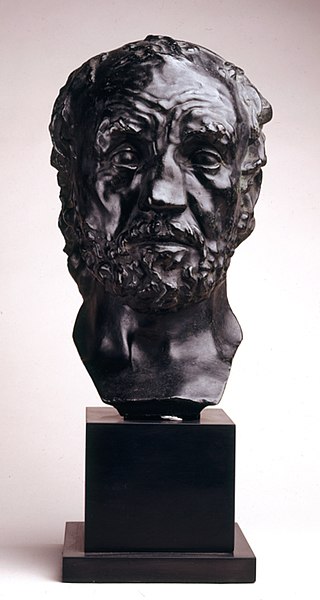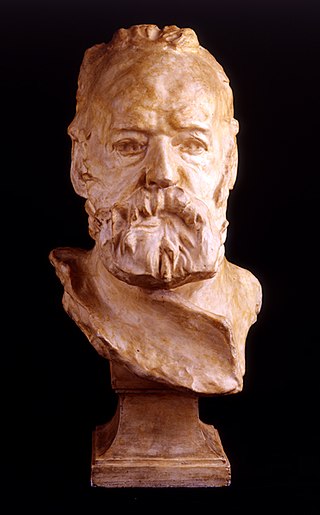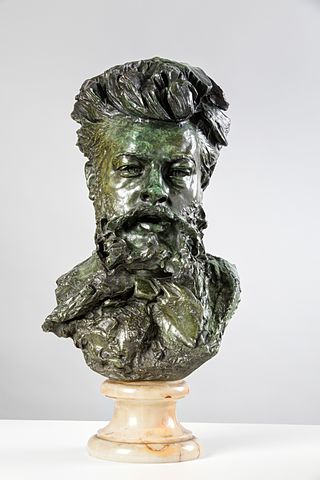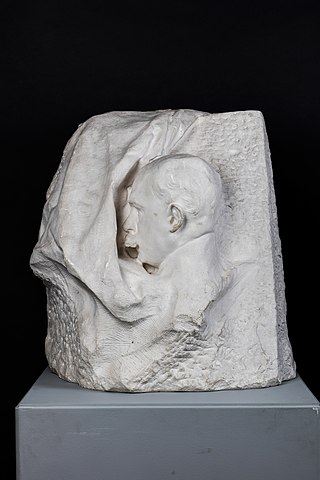| The Old Tree | |
|---|---|
 Bronze cast of the sculpture | |
| Artist | Auguste Rodin |
| Year | 1885 |
The Old Tree is a plaster sculpture by the French artist Auguste Rodin, originally conceived as part of his The Gates of Hell project. [1]
| The Old Tree | |
|---|---|
 Bronze cast of the sculpture | |
| Artist | Auguste Rodin |
| Year | 1885 |
The Old Tree is a plaster sculpture by the French artist Auguste Rodin, originally conceived as part of his The Gates of Hell project. [1]
Rodin produced it in 1885, only a year after the formation of the Salon des Independents. It measures 39.3 cm × 38.4 cm × 27 cm (15.5 in × 15.1 in × 10.6 in) and shows a nude young woman clinging to an old man holding his arms out like a tree, contrasting several opposites - male and female, youth and age, softness and roughness.
The work was cast from the plaster original by Georges Rudier's studio in black and green patina bronze. The bronze was exhibited in 1900 in the Pavilion de l'Alma and the La Plume salon - in La Revue Blanche, Felicien Fagus wrote:
At once human, animal and vegetable ... hairy and cracked, with branches and leaves, in which we can recognise Mercury and a small, wild and familiar woodland deity, who is none other than Little Fauna, and far from mythological themes, [Rodin] sees the symbol of an absolute faith in nature as the very substance of life. [2]

The Martyr or The Little Martyr is a c.1885 plaster sculpture of a naked dead or sleeping female figure by Auguste Rodin, now in the Musee Rodin.

The Alsatian Orphan / L'Orpheline Alsacienne is a sculpture made by the French artist Auguste Rodin (1840-1917). In the beginning of his career, Rodin made decorative pieces. This piece was created during this phase.

Man with the Broken Nose is a sculpture by Auguste Rodin created between 1863 and 1864 and approved by the Salon in 1875. It is considered the first by Rodin in which life is represented over the grace pervading the academic circles and aesthetic of the time.

Fugitive Love is a sculpture by Auguste Rodin made between 1886 and 1887, both sculpted in marble and cast in bronze. It represents a man and a woman embracing each other on top of a rock. More specifically, the author was inspired by the story of Francesca da Rimini's love affair with Paolo Malatesta, an allusion to Dante Alighieri's depiction of lust on the second circle of Hell in his Inferno.

Pierre de Wissant is a bronze sculpture by French artist Auguste Rodin, part of his sculptural group The Burghers of Calais. This sculpture represents one of the six burghers who, according to Jean Froissart surrendered themselves in 1347, at the beginning of the Hundred Years' War (1337–1453), in order to save the inhabitants of the French city of Calais from the English laying siege to the city.

The Bust of Victor Hugo is an 1883 patinated plaster sculpture by the French artist Auguste Rodin of the Romantic writer Victor Hugo. It is now in the Museo Soumaya in Mexico City.

The Bust of Maurice Haquette is an 1883 bronze sculpture by the French artist Auguste Rodin, measuring 53.5 by 26.7 by 41.1 cm.

Danaid is a sculpture by Auguste Rodin, based on the account in the Metamorphoses of Hypermnestra, eldest of the Danaïdes.

Eve is a nude sculpture by the French artist Auguste Rodin. It shows Eve despairing after the Fall.

The Athlete is a 1901-1904 black-patina bronze sculpture by the French artist Auguste Rodin It measures 39,4 × 27,5 × 24,3 cm.

The Maiden Kissed by the Ghost is an 1880 sculpture by the French artist Auguste Rodin. It was first exhibited at his fourteenth exhibition, hosted by the National Society Salon. One of the marble versions of the work is now in the Museo Soumaya in Mexico City.

The Kneeling Man is a work originally conceived in 1888 by the French artist Auguste Rodin for his The Gates of Hell project.

Glaucus is a sculpture by the French artist Auguste Rodin, first conceived in 1886 as a representation of the mythological figure Glaucus, son of Poseidon. Originally made in plaster, bronze casts of it are now in the Brooklyn Museum and the Museo Soumaya.

Youth Triumphant is one of the sculptures created by Auguste Rodin as part of the planning for his The Gates of Hell. It was inspired by Jean Dampt's The Grandmother's Kiss, exhibited in 1893. That work shows a young woman resting in the arms of an old woman, with the pair deeply kissing.

Young Mother is a bronze sculpture by Auguste Rodin with a brown and green patina, conceived in 1885 and cast by the Rudier Foundry.

Ovid's Metamorphoses or The Satyrs is a sculpture by Auguste Rodin, created as part of The Gates of Hell.

Meditation or The Interior Voice is an 1886 sculpture by Auguste Rodin, showing a young woman resting her head on her right shoulder.

Octave Mirbeau is an 1895 plaster relief by Auguste Rodin of the writer Octave Mirbeau, now in the Museo Soumaya. He had got to know him thanks to The Age of Bronze and The Gates of Hell - Mirbeau visited Rodin's studio, published the first description of Gates in the review La France, promoted Rodin's other work and died only a few months before the sculptor.

Suzon is an early bust of a woman by Auguste Rodin, created between 1872 and 1873 when he wholly worked on commissions. It was inspired by late 18th century Romantic works whilst Rodin was in exile in Brussels due to the Franco-Prussian War. He created it in homage to Albert-Ernest Carrier-Belleuse, another sculptor also in exile there who was highly influential on Rodin's early works.

Torso of Adele is an 1878-1884 sculpture by the French artist Auguste Rodin, originally modelled in plaster before being worked in terracotta.